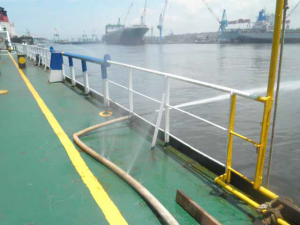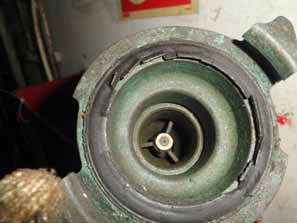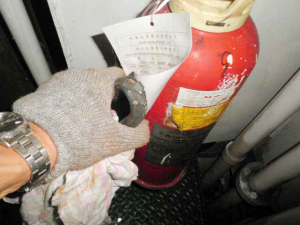This website uses cookies so that we can provide you with the best user experience possible. Cookie information is stored in your browser and performs functions such as recognising you when you return to our website and helping our team to understand which sections of the website you find most interesting and useful.
MAINTENANCE OF FIRE PROTECTION EQUIPMENT ON BOARD A SHIP: FIRE EXTINGUISHERS, HOSES AND MORE
Published: 1 April 2014
On this page:
- Introduction
- Fire hoses
- Portable fire extinguishers
- Fixed carbon dioxide extinguishing systems
- Self-contained breathing apparatus
- Emergency escape breathing devices
The International Convention for the Safety of Life at Sea (SOLAS) regulation II-2/14 requires maintenance, testing and inspections of fire protection systems and appliances on board to be carried out based on the International Maritime Organization (IMO) guidelines, which address the minimum recommended level of maintenance and inspections for the maintenance plan required by SOLAS.
IMO MSC.1/Circ.142 guidelines recommend that certain maintenance procedures and inspections should be performed by competent crew members who have completed an advanced fire-fighting training course. Whilst other procedures should be performed by individuals specifically trained in the maintenance of such systems i.e. authorised representatives of the manufacturers.
The on board maintenance plan should also indicate which parts of the maintenance and inspection programme is to be carried out by competent crew members and which are to be completed only by individuals specially trained in the maintenance of such systems.
The effectiveness of the maintenance on board will vary depending on the company’s ethos, work practices and the available budget. Unfortunately, feedback and reporting from our routine surveys has made it increasingly apparent that maintenance is one of the areas that is given a low priority when allocating available funds and resources, particularly on a ship where the operating cost is higher.
The IMO and SOLAS guidelines state that portable fire extinguishers state should be examined annually by a competent person, who may be assumed to be the chief officer or second engineer, or their representatives.
The basic maintenance includes a requirement to :
- Examine the extinguisher body externally for corrosion or damage that could impair the safe function of the extinguisher
- Carefully check the plastic head cap for signs of UV degradation
- Check the condition of the discharge hose and make sure that it meets the manufacturer’s specifications
- Weigh the extinguisher to check that the weight corresponds with the manufacturers specifications and the recorded weight when first commissioned or last recharged
The third officer, often in collaboration with the second officer and occasionally the fourth engineer, typically serves as the designated fire safety officer and therefore is the person responsible for checking and maintaining relevant fire fighting and life safety equipment.
Whilst there are always exceptions, it is unusual for these officers to be adequately trained to properly and effectively service all safety equipment on board a particular ship. It is customary for the new joining officer to get a handover from the officer being relieved, which should be written down and if there is sufficient time, should include a brief walk through and perhaps the location of spare parts. Unfortunately, the need to regularly check the manufacturer’s documentation to confirm the fire extinguisher’s recorded weight or determine if the plastic cap is degraded and requires replacement is frequently overlooked.
On ships engaged in short sea routes or those with a gross tonnage (GT) below 3000, the safe manning requirements are reduced accordingly. It is not uncommon for the deck officer team to consist of a master, chief mate, and one officer responsible for navigation watch. However, this reduction in manning levels affects the time and personnel available for planned maintenance tasks. The company is responsible for ensuring that the ship’s crew can effectively maintain the vessel, considering its specific trade, as well as complying with the Maritime Labour Convention (MLC) requirements. Alternatively, the company must ensure that the necessary maintenance is carried out with adequate support from onshore resources.
Crew exercises, such as fire drills, should be scheduled in a way that minimises disturbance during rest periods. Seafarers who are called to participate in these drills while they are on a rest period are entitled to receive additional rest time to compensate for the time spent on the drills.
Maintenance is crucial to ensure that equipment functions as intended, not only during routine operations but especially when needed in emergency situations. It also provides the requisite proof, when being inspected or in the case of equipment failure, that the required duty of care was undertaken in ensuring that the equipment was in good working order. Effective and timely maintenance also reduces downtime and losses due to equipment malfunctions and having all safety equipment readily available for use when needed may save lives.
Efficient maintenance practices must be relevant to manufacturers’ recommendations and planned for appropriate intervals that are also based on usage and age of equipment. The planned maintenance routine needs to be dynamic enough to encompass any interim equipment failures or deficiencies.
A brief summary of areas to watch out for with respect to some safety equipment is as follows:
FIXED CARBON DIOXIDE FIRE EXTINGUISHING SYSTEMS
The onboard maintenance plan should be included in the ship’s safety management system and should be based on the system manufacturer’s recommendations including:
- maintenance and inspection procedures and instructions;
- required schedules for periodic maintenance and inspections;
- listing of recommended spare parts; and
- records of inspections and maintenance, including corrective actions taken to
- maintain the system in operable condition.
At least every 30 days a general visual inspection should be made of the overall system condition for obvious signs of damage, and should include verification.
A minimum level of maintenance and inspections should be carried out annually in accordance with the system manufacturer’s instructions and routine safety precautions.
SELF-CONTAINED BREATHING APPARATUS
- SCBA should be inspected weekly to ensure that they are in the correct pressure range
- SCBAs on ships carrying gases, chemicals etc shall be inspected at least monthly by a responsible officer
- All SCBAs shall be examined at least annually as part of the annual statutory safety equipment survey
EMERGENCY ESCAPE BREATHING DEVICES (EEBD)
- SOLAS 74 requires at least two EEBDs to be located in the accommodation spaces
- Additional EEBDs to be placed in the machinery spaces based upon persons, ease of access etc
- Sufficient spare EEBDs should be kept on board to replace units that are used, reach their expiry date, or otherwise become unserviceable
- The EEBD should be examined and maintained in accordance with the manufacturer’s instructions
- In the absence of manufacturer’s instructions, hydrostatic testing should be carried out at intervals not exceeding five (5) years, unless specifically prohibited by the manufacturers
- EEBD SHALL NOT be used to enter an enclosed shipboard space in which the atmosphere is known or suspected to be oxygen-depleted or enriched, toxic or flammable

 English
English


